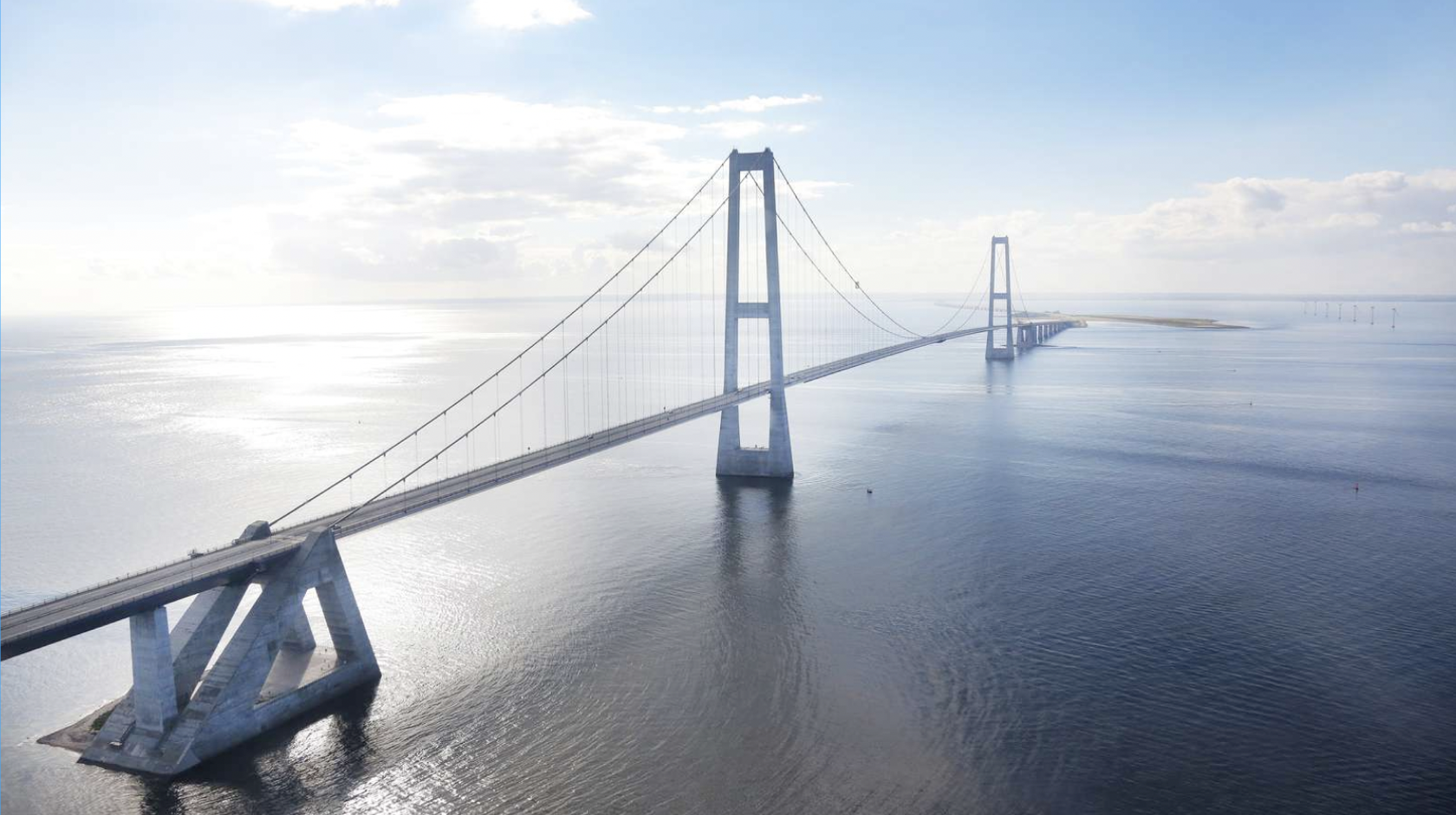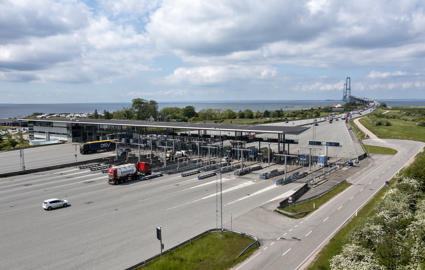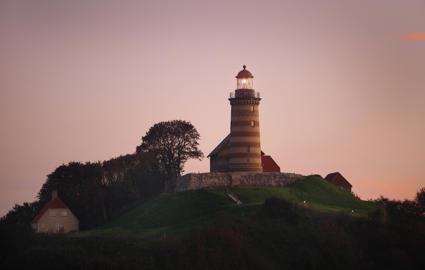The Storebælt Bridge
The Storebælt fixed link comprises two bridges and a tunnel. With its 1,624m free span, the East Bridge is the most striking.
Denmark's link
Denmark is the land of the bridges. As Danes, we are blessed with long, beautiful coastlines and parts of the country separated by water. This makes bridges an indispensable part of our infrastructure.
The Storebælt link consists of two bridges and a tunnel, which forms the 18 km long, fixed connection between eastern and western Denmark. The Storebælt link is the crown jewel among the Danish bridges. As a proud monument, it connects Zealand and Funen and forms a traffic lifeline between east and west. The great social significance of the connection obliges.
Road and railway across Storebælt must be open 24 hours a day - all year round.
The Storebælt link is a piece of unique engineering and is one of the world's largest bridge and tunnel constructions. The connection replaced 3 ferry routes on the Storebælt, but there are still ferries across the Kattegat and across the waters between Lolland and Langeland.
The Storebælt link is, however, the most important traffic artery between the regions.
Facts
The East Bridge
The East Bridge
The 6.8 km road bridge between Zealand and Sprogø is part of the Storebælt Bridge and, with its main span of 1,624m, is the world’s second longest suspension bridge.
At its highest point, the road deck is 75m above sea level, which is why wind conditions have a major impact on traffic on the bridge. The gradient of the bridge is a maximum of 2.1 per cent, i.e. somewhat less than the highest gradients of other Danish motorway sections, which rise up to 3.5 per cent.
The East Bridge’s bridge deck is made of steel while the two pylons, two anchor blocks and 19 bridge piers are made from reinforced concrete.
The concrete sub-structure comprises pylons and anchor blocks as well as bridge piers and abutments. The steel superstructure comprises spans and cables.
The suspension bridge between the two anchor blocks is around 2,700m long. It is made up of the free span between the two pylons of 1,624m plus the two side spans between the pylons and anchor blocks of 535m each.
The East Bridge spans Storebælt’s Eastern Channel, an international waterway with a depth of approximately 60m. Every year, around 25,000 ships pass under the Storebælt bridges. Approximately 95 per cent pass under the East Bridge, which has a navigational clearance of 65m. The East Bridge’s large, free span was determined by means of extensive manoeuvre simulations for maritime traffic and helps to ensure minimum risk of collision.
The pylons, anchor blocks and bridge piers nearest the passage span have been constructed so that any collision would not cause critical damage to the bridge. As an extra safety precaution, a system that monitors shipping in the Storebælt has been set up. The system helps to ensure that all large vessels sail though the Eastern Channel.
East Tunnel
East Tunnel
The Storebælt fixed link comprises two bridges and a bored tunnel – the East Tunnel. The tunnel is a bored tunnel slightly over 8 km long.
The East Tunnel for rail traffic is 8,024m long and comprises two separate tunnel tubes with one track in each. The two tunnel tubes are connected by 31 cross passages, which serve as emergency exits and contain important installations.
The East Tunnel is a bored tunnel. Four boring machines, one in each direction in each tunnel tube, were specially manufactured for the task. The 40 cm thick tunnel walls comprise 62,500 bolted concrete elements.
There is between 12 and 40m from the sea bed to the top of the tunnel. At its deepest point, the tunnel is 75m below sea level.
The West Bridge
The West Bridge
The West Bridge is a 6.6 km long, combined road and rail bridge resting on 63 bridge piers and two abutments. Both the super and sub-structures are made of reinforced concrete. The West Bridge curves horizontally with a radius of 20 km. Chosen for both aesthetic and safety reasons, this gives drivers a varied experience during their crossing of the West Bridge.
Due to the limited navigational clearance of 18m, shipping in the Western Channel is restricted to vessels of max. 1,000 GRT (Gross Register Tonnage).
The two passage spans for north and south bound shipping are marked with double leading lights and red/green buoyage (beacons and lights). In addition, the navigation spans are equipped with automatic fog detectors and foghorns. There is 260m between the north and south bound navigation channels.
To further enhance safety, a system has been set up to monitor shipping in Storebælt. This helps to prevent large vessels accidentally sailing through the Western Channel instead of the Eastern Channel.
Pylons
Pylons
With their 254 m, the pylons are among Denmark's highest points. The caissons, the official name of the foundations for the pylons, were cast at a factory in Kalundborg and towed 70 km to the bridge site. Each caisson weighs 32,000 tons and is placed on stone beds to provide them with a stable surface.
The rest of the pylons were cast on site in 4m lifts, in a so-called climbing formwork that kept the concrete dry and ensured hardening.
Anchor blocks
Anchor blocks
The purpose of the East Bridge's anchor blocks is to anchor the very significant forces from the main cables. Each anchor block weighs quite a lot in itself, but in addition, each of them is provided with a ballast of sand and iron ore, which gives a total weight of 325,000 tons.
Inside the anchor blocks, the main cables are attached. Each cable consists of 37 wire bundles, which are anchored to the bottom of the anchor block. Each anchor block is approx. 63 m high.
Bridge girders and abutments
Bridge girders and abutments
The ramps and abutments of the East Bridge and the first bridge pier have been cast on site due to the shallow water. The other bridge piers are prefabricated and shipped out to the bridge site.
There are a total of 19 bridge piers, of which 12 between Zealand and the eastern anchor block and 7 between Funen and the western anchor block. A bridge pier weighs an average of 6,000 tonnes. The suspension bridge is held in place by two 83 cm thick and 3 km long cables.
Cables
Cables
The roadway is supported by two parallel cables, which run from one anchor block over the top of the two pylons to the other anchor block.
The cables are each approx. 3 km long and 83 cm in diameter. Each cable consists of a long series of wires of 5.38 mm, and the total number of wires in each cable is 18,648 pieces. To hold the cables together, steel wires are wrapped around them. Finally, they have been finished to avoid rust.
In 2014, Storebælt began installing a dehumidification system on the main cables to keep them in good condition. The dehumidification system was completed in September 2015.
The dehumidifier blows dry air through the main cables, thereby removing any moisture. To ensure that the dehumidified air can flow from the inlet to the exhaust sleeves, the main cable is made airtight by wrapping it with a material called “reinforced elastomer” (CableguardTM) and sealing around cable clamps.
The construction work for the Storebælt Fixed Link took place from 1988-1998. The motorway across the Storebælt was opened on 14 June 1998, while the railway opened the year before, 1 June 1997.
The total construction costs for the entire Storebælt project amounted to DKK 21.4 billion (in 1988 prices).
The costs were applied roughly equally on the road and rail link. To cover the construction costs, A/S Storebælt has raised loans in Danish and international capital markets.
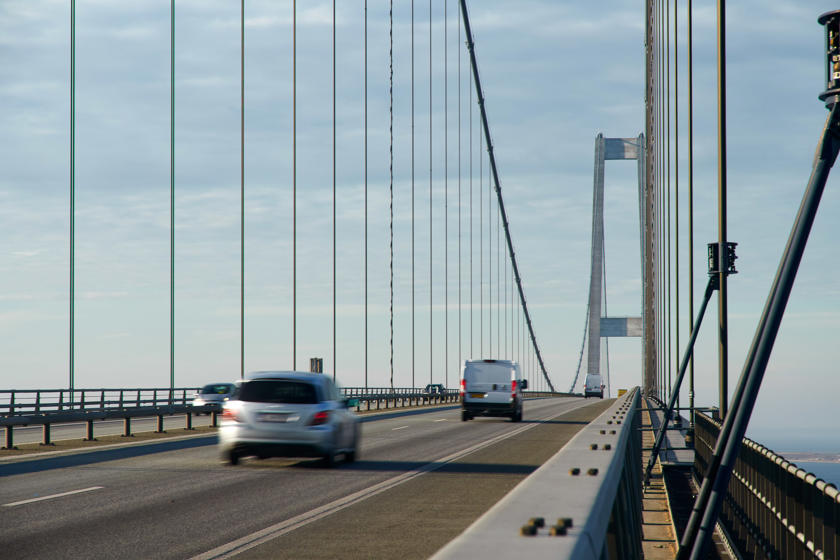
Traffic & Safety
As an infrastructure owner, Sund & Bælt focuses on traffic safety. In our road safety policy, we are committed to making a proactive effort to prevent accidents at our facilities.
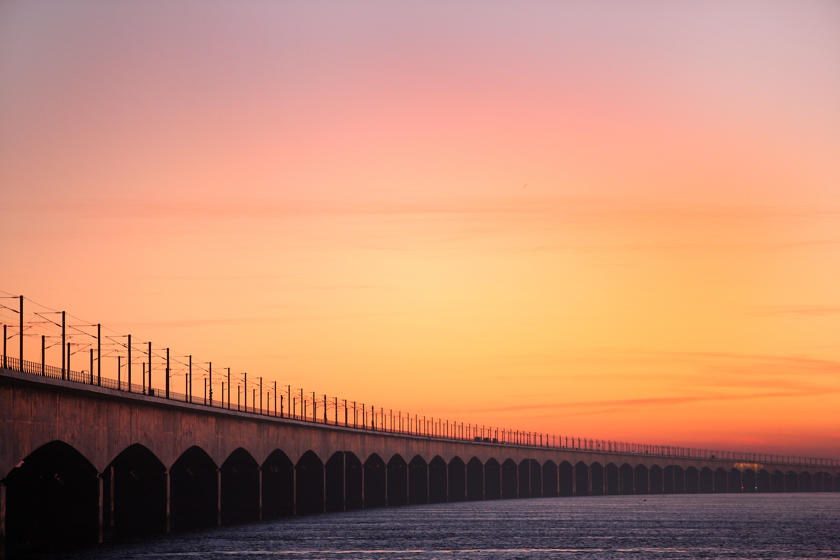
Milestones in the history of the Storebælt Fixed Link
- 10 June 1987: The Danish parliament adopts the Construction Act for the Storebælt fixed link.
- 30 August 1990: The boring machine Selandia begins the boring of the southern tunnel tube.
- 12 April 1991: The floating crane, Svanen, places the first West Bridge caisson off Knudshoved.
- 14 October 1991: The two tunnel tubes from the Sprogø side are flooded due to water penetrating through the seabed at the front of the boring machine, Jutlandia.
- October-November 1992: The world’s largest underwater groundwater lowering starts. The MOSES project removes some of the pressure in the subsoil to facilitate the work of the tunnel boring machines.
- 21 April 1993: The first caisson for one of the East Bridge’s pylons is sailed from Kalundborg and immersed on the bottom of Storebælt.
- 15 October 1994: Prince Joachim is the first human through the tunnel.
- 14 June 1998: Queen Margrethe II opens the Storebælt fixed link.
